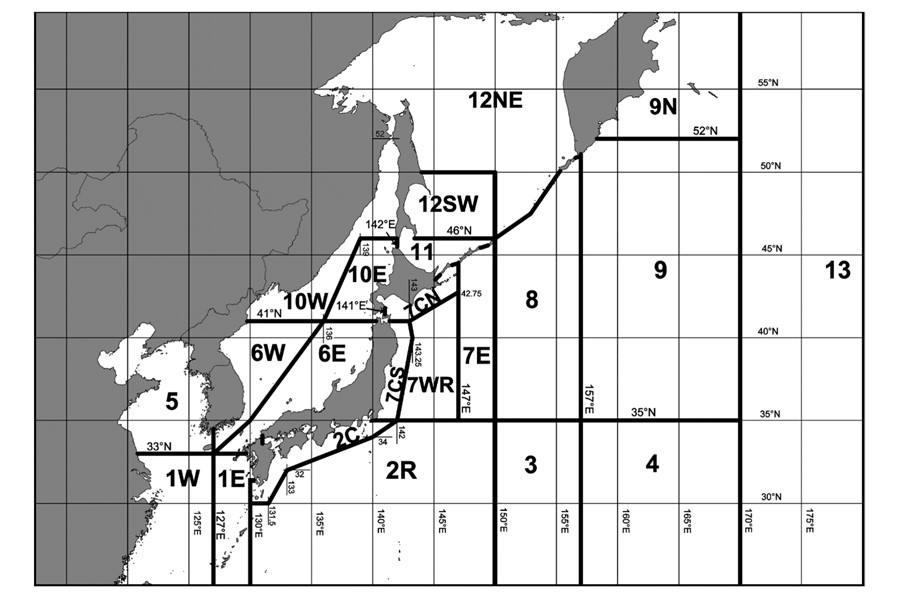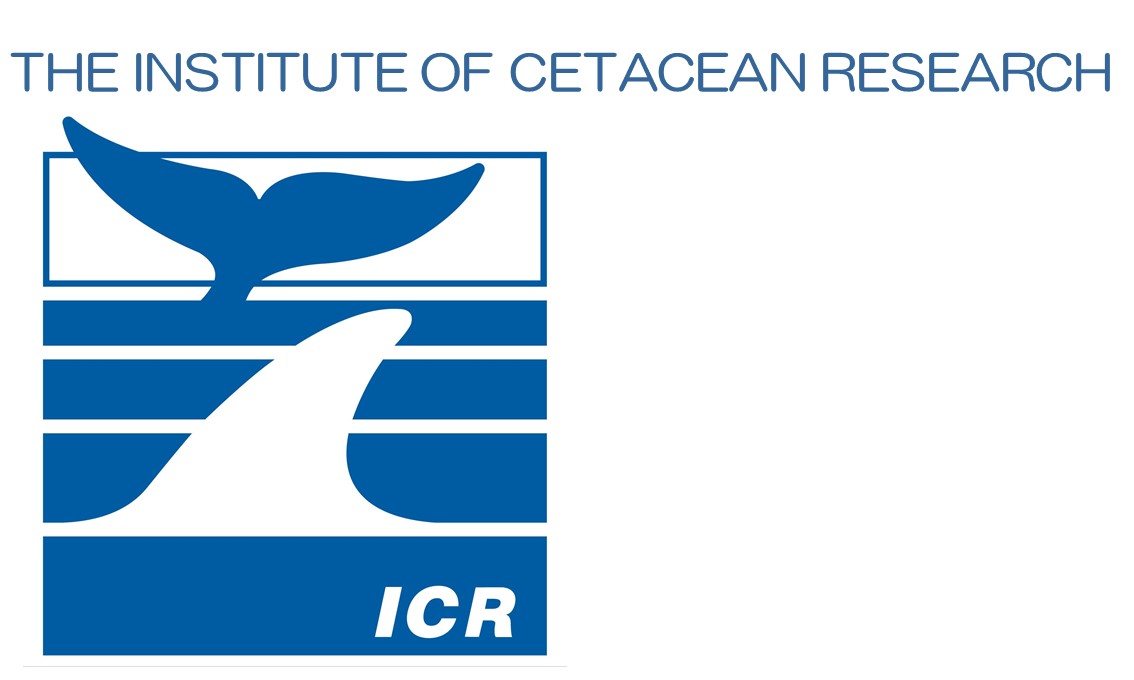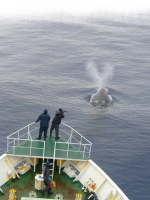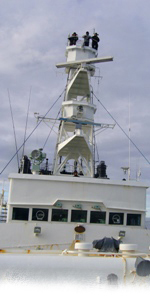- You are here:
- Home>
- English Sitemap>
- RESEARCH>
- Past Research>
- Western North Pacific>
- NEWREP-NP
NEWREP-NP (the New Scientific Whale Research Program in the western North Pacific) -Outline
The Judgement of the International Court of Justice (ICJ) regarding the case ‘Whaling in the Antarctic’ only affected JARPAII. However, the Government of Japan (GOJ) decided to halt the JARPNII program in the western North Pacific as well with the idea of developing a new research program that fully considered the guidelines offered by the Court’s Judgement for the design of whale research program under Article VIII of the International Convention for the Regulation of Whaling (ICRW). Therefore, the NEWREP-NP was developed following the same rationale and style of NEWREP-A, i.e., considering the guidelines provided by the Court (see NEWREP-A section).
Objectives
The research objectives of NEWREP-NP were aimed at preparing for the scenario of future sustainable commercial whaling on some abundant whale species in the western North Pacific under the International Whaling Commission (IWC)’s Revised Management Precedure (RMP).
Primary Objective 1:
Contribution to optimizing the establishment of sustainable catch limit for common minke whales in the coastal waters of Japan.
The aim under this objective was to provide new scientific information to assist/improve the RMP Implementation being conducted by the IWC Scientific Committee (SC) for western North Pacific common minke whales at that time. Specifically, the idea was to provide scientific information to eliminate what the Institute of Cetacean Research (ICR) considered unrealistic scenarios in the Imprementation Simulation Trials (ISTs) with respect to stock structure hypotheses and productivity. This would require improved knowledge about relevant biological/ecological parameters; continuing survey/monitoring of population abundance; and strengthening scientific evidence on stock structure and population dynamics.
Primary Objective 1 had four secondary objectives:
(a) investigate the spatial and temporal occurrence of J stock common minke whales around Japan, by sex, age and reproductive status;
(b) estimate the abundance of the J and O stocks in coastal waters of Japan;
(c) verify whether there is any structure or not in the O stock common minke whale in the Pacific side of Japan; and
(d) improve RMP trials by incorporating age data in their conditioning.
Primary Objective 2:
Contribution towards the RMP/IST for North Pacific sei whale.
The North Pacific sei whale had not been the subject of previous RMP Implementation, however the IWC SC had started an in-depth assessment of this species in 2015 that when completed could lead to such an Implementation. While a substantial amount of scientific information on sei whales had been accumulated by that time through research programs such as the JARPNII in the western North Pacific and the IWC-POWER (Pacific Ocean Whale and Ecosystem Research) in the central and eastern North Pacific, these data had not been yet used in population assessment models. NEWREP-NP under this objective would collect the necessary scientific information to complement the information obtained previously from other sources, ultimately to assist/contribute to an RMP Implementation.
Primary Objective 2 had four secondary objectives:
(a) abundance estimates for North Pacific sei whale taking account the additional variance;
(b) estimation of biological and ecological parameters in North Pacific sei whales for RMP Implementation;
(c) study of the pattern of movement of whales of the ‘pelagic stock’ within the feeding grounds and between feeding and breeding grounds; and
(d) specification of future RMP ISTs for North Pacific sei whales.
Thus, the primary, secondary and ancillary objectives of NEWREP-NP were important for the conservation and management of whales and the ecosystem of which the whales are an integral part.
Research area and period
NEWREP-NP was planned for a period of 12 years with a mid-term review after the first six years. In practice, it was conducted only for three years (2017-2019) after which the research program was halted when Japan withdrew from the IWC in 2019. The research area included sub-areas 7, 8 and 9 in the figure below, with different sub-areas covered in each year depending on objectives.

Sample sizes and actual catches
| Year | Common minke whale | Sei whale | ||
| Sample size | Catches | Sample size | Catches | |
| 2017 | 170 (43 O; 80 CP; 47 CA) | 43 O; 38 CP; 47 CA | 134 | 134 |
| 2018 | 170 (43 O; 80 CP; 47 CA) | 43 O; 80 CP; 47 CA | 134 | 134 |
| 2019 | 170 (43 O; 80 CP; 47 CA) | 0 O; 47 CP; 32 CA | 134 | 0 |
O: Offshore component.
CP: Coastal Pacific component.
CA: Coastal Abashiri.
The annual sample size of common minke whale was calculated as 170. The number in sub-area 11 was related to Objective I, secondary objective (a) above for the first 6 years (47 animals) starting in 2017; the number in sub-areas 7-9 was related to Objective I, secondary objective (d) above (123 animals) starting in 2017 (43 whales taken in offshore waters and 80 in Pacific coastal areas). The estimated annual sample size for sei whale was calculated by ICR as 134 animals in relation to Objective II, secondary objective (b) above with the sampling starting in 2017 (see table above).
Review of NEWREP-NP research proposal and results
The original research proposal was reviewed and commented upon during the 2017 Panel workshop under the IWC SC ‘New Review Procedure’.This new procedure was developed by the IWC SC in 2008 to increase the level of consensus. The most important component of the new procedure was an Expert Panel workshop, with specific Terms of References for both review of new proposals and review of research results from existing and completed special permit research programs. The workshops had open and closed sessions and scientists from the Contracting Government participated only in the open sessions to present research proposal and results, and to answer points of clarification from the Panel.
The report of the Panel workshop was presented to the IWC SC annual meeting (Doc. SC/67a/Rep1). A revised version of NEWREP-NP research plan that considered the suggestions from the Panel workshop was presented to the IWC SC meeting in 2017 (Docs. SC/67a/SCSP/10 and 13).
There was no review and comments of NEWREP-NP research results as the program had halted prematurely in 2019.
The NEWREP-NP program started in 2017 and was planned for a period of 12 years. It was halted in 2019 after Japan withdrew from the IWC.
The NEWREP-NP program was designed in the same way as NEWREP-A by taking into account the guidelines and the seven elements in the ICJ Judgment on the Antarctic Whaling Case for designing research programs under special scientific permits under Article VIII of the ICRW.
The primary research objectives were directly related with management under the RMP, the first a contribution to optimize the establishment of sustainable catch limit for common minke whales in the coastal waters of Japan, and the second to contribute to the RMP/IST for North Pacific sei whales.
The annual proposed sample sizes for the lethal component of the NEWREP-NP were 170 common minke whales and 134 sei whales.
NEWREP-NP proposal was duly reviewed and commented by the IWC SC through a specific workshop.
Further reading




